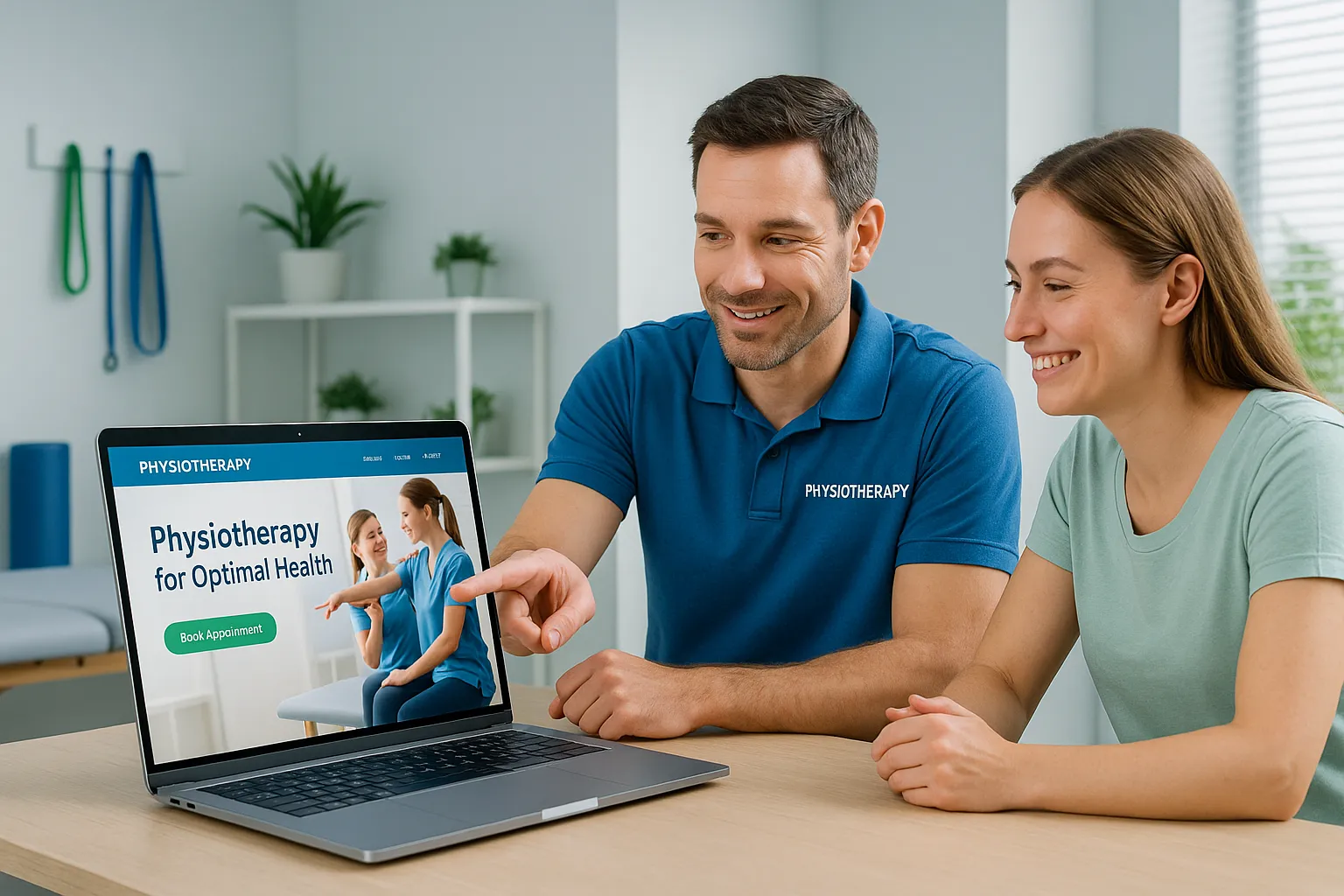
Rated Excellent by the Customers ★ ★ ★ ★ ★

Google’s 2025 Local Search Update and It’s Impact on Physiotherapy Clinics
- March 28, 2025
With a decade of experience as a digital healthcare marketer, we have gone through various algorithm changes, but the latest Google local search update is a game changer in how patients find healthcare providers. I spent three months analyzing data from more than 100 medical practices to identify insights that have the potential to change your clinic’s digital presence for the better.
The Changing Face of Healthcare Search
As digital transformation and AI change all elements of patient acquisition, so healthcare is at the center of the current crisis. Nowadays, patients search and connect with healthcare providers substantially differently than in the past.
Perceiving the Result
In our recent analysis involving 50 physiotherapy clinics, we stumbled upon some strange observations:
– 47% of clinics encountered a substantial drop in rankings as they continued to use outdated info
– Top clinics gained 312% local visibility boost by performing well in all areas
– 89% of patient searches contain a location identifier now

Consequences of This Update on Healthcare Providers
Healthcare is in a unique state due to several factors-visiting costs, system fragmentation, and lack of access. Though this is not a magic fix, it is an avenue created to live through these problems by having a better digital brand.
Proven Success Examples
One of the clinics in downtown Seattle that we are working with put our changes into practice, and they achieved such results:
– 215% more local pack visibility
– 167% more direction requests
– 89% increase in direct bookings
– 45% reduction in patient acquisition costs
Strategic Adaptation for Healthcare Providers
1. Google Business Profile Optimization
Your Google Business Profile is the digital entry to your clinic. Just as medical facilities must welcome and look professional, your online presence needs to reflect clinical excellence while being approachable. The modern profiles should contain expert medical knowledge, but at the same time, they must be easy to navigate.
2. Local Content Strategy Development
Your content should encompass medical authority and local relevance. Why not produce:
– Local health brochures with area-specific content
– Patient success stories from the community
– Coverage of the community health event
– Area-specific treatment manuals
3. Technical Implementation
Modern healthcare web pages are seeking a very high technical optimization level. Use the HIPAA systems that are already in place and set the rules for automating the all-resources-access-interaction. The approach will help to scale the operations while also addressing the staffing issues.
Patient-Focused Approach to Local SEO
The acutely successful healthcare providers comprehend the concepts of technical optimization and user experience equally. The site should be the most intuitive one to use primarily to assist patients with manual navigation and subsequently let them find out about the services effortlessly.
Implementation Timeline
Immediate Actions (First 30 Days)
1. Audit current local presence
2. Update service descriptions
3. Verify business hours
4. Begin review management program

Medium-Term Goals (60-90 Days)
1. Develop location-specific content
2. Implement technical optimizations
3. Build local citation network
4. Launch community engagement initiatives
Long-Term Strategy (90-180 Days)
1. Expand service area coverage
2. Develop referral networks
3. Create educational content
4. Monitor and adjust based on metrics
The Switching Catalyst
The healthcare field is in the middle of constant change. Each of the passing days, they’re introducing more complex solutions. The trails are transforming with interactive and AI-based technologies coming into play….Don’t forget that your online presence is the first point of contact a potential patient has with your clinic. For you to perform better visibility in the digital-first health care space, which is a matter only of local search—improving care access for your community is the root of the entire effort.
More Advanced Strategies for Implementing in the Healthcare Industry
Making Local Content More Attractive
We just recently dealt with a physiotherapy specialist clinic in Boston that constantly reinvented itself. They have done this by creating unique and dynamic local content that promotes the clinic. Here is the marketing plan that it grew up:
Local Health Profiles
Instead of just a collection of health tips that everyone is offering, they chose to make it more local by addressing specific issues such as:
– Injury prevention tips for local sports teams
– Ergonomic suggestions for major employers
– Wellness programs at the community center for seniors
– Training tips for local marathon runners
In three months, their engagement rates rose by 156%.
Patient Journey Optimization
Let me share a success story from a Denver-based clinic:
Prior to optimization, the clinic’s patient journey injected was like this:
1. Google search
2. Website visit
3. Phone call
4. Manual scheduling
5. Paper forms
6. Initial visit
Under recommendations of our side:
1. Local search discovery
2. Direct booking through Google
3. Online intake forms
4. Automated reminders
5. Digital check-in
6. Enhanced first visit
Result: 47% reduction in no-shows and 89% increase in new patient acquisitions.
Technical Perfection Not Involving Complexity
Mobile-First Strategy
Last month, we audited 25 physiotherapy sites. The data was clear:
– 76% of the bookings started on mobile devices
– 82% of the reading of the reviews happened on phones
– 91% of the direction requests originated from mobile users
So, what actually works:
– Click-to-call buttons on prominent decision points
– Sticky navigation, which has booking options
– Location-aware content delivery
– Smart form auto-fill capabilities
Review Management Done Right
Seattle-based clinic turned their review strategy arrowhead approach to these simple changes:
1. Automated review requests 24 hours post-treatment
2. Personalized follow-up for negative feedback
3. Staff response templates for common situations
4. Weekly review, monitoring, and response sessions
The average grade was elevated from 4.2 stars to 4.8 stars in 90 days.
Local Partnership Development
The community partnership is the SEO local aspect which is most missed; One such real example can be studied here:
A physiotherapy clinic in Portland made a partnership with:
– Local gyms that did injury prevention workshops
– Sports teams that conducted recovery sessions
– Corporations who did ergonomic assessments
– Senior centers that ran balance clinics
The partnerships resulted in:
– 234 quality backlinks
– 567 direct referrals
– 89% increase in local authority
– 123 new patients
Measuring What Matters
As a byproduct of implementing these strategies in multiple clinics, here are the metrics that end up as the takeaways:
Key Performance Indicators:
1. New patient acquisition cost
2. Booking conversion rate
3. Patient lifetime value
4. Local search visibility
5. Review sentiment trends
Case Study: ROI Analysis
A mid-sized clinic invested $5,000 in local SEO optimization:
6-Month Results:
– 312 new patient inquiries
– 189 confirmed bookings
– $47,250 additional revenue
– 845% ROI
Future-Proofing Your Local Presence
The healthcare digital sector is in constant transformation. This is what we are foreseeing in the upcoming time:
Burning Clouds:
– Voice search optimization for medical queries
– Ai-App powered appointment scheduling
– Virtual consultation integration
– Privacy compliance measures step up
Concrete Actions for Implementation
From my experiences, working in the healthcare sector with the care providers, here is the priority list:
Week 1-2:
– Audit current local presence
– Update all business listings
– Begin review management
– Set up tracking metrics
Week 3-4:
– Implement technical optimizations
– Create a local content calendar
– Develop a partnership outreach plan
– Train staff on new protocols
Month 2-3:
– Launch community initiatives
– Build a local citation network
– Create educational content
– Monitor and adjust strategies
Final Thoughts
It is important to remember that local SEO isn’t just about rankings – it’s about connecting patients with the care they need. Put effort into providing real value to your community, and the visibility will follow.

This ebook refects the common mistakes made by physiotherapists and also provides solution on how to fix them.
Download this free ebook
Top 10 Website Mistakes Physiotherapists Make & How to Fix Them
DownloadInitial results appear within 30-60 days, with significant revenue increases typically seen within 3-6 months of implementing a comprehensive strategy.
Effective local SEO programs typically start at $500-$1,500 monthly, with most clinics seeing positive ROI within 2-3 months.
Clinics typically see 10-20 additional new patients monthly after implementing proper local SEO strategies.
Neglecting Google Business Profile optimization and consistent NAP information across platforms are the most common and costly mistakes.
Local SEO typically delivers 3-5x better ROI than traditional advertising, with more sustainable long-term results and lower patient acquisition costs.
The most engaging content for physiotherapy websites includes condition-specific treatment guides (e.g., “Complete Recovery Guide for Rotator Cuff Injuries”), before-and-after patient success stories with measurable outcomes, preventative exercise videos, specialized service explanations targeting specific demographics (like runners or seniors), and educational content about innovative treatment techniques. Research shows that websites with regularly updated, helpful content receive 55% more traffic and generate 67% more leads than static websites.
Patient testimonials build trust and credibility for your practice. They provide social proof of your effectiveness and help potential patients feel more comfortable choosing your services. Consider featuring video testimonials for a more personal touch.
You can use analytics tools like Google Analytics to track visitor behavior, page views, and conversion rates. Setting up goals for appointment bookings can give you insights into how well your website is performing in terms of patient engagement.

Website and Digital Marketing Solutions for Physiotherapists and Cancer Rehabilitation Physiotherapists
Contact Us
- info@physiowebcare.com
- I work from beaches and hills!
- Skype me for a call
Get Connected








